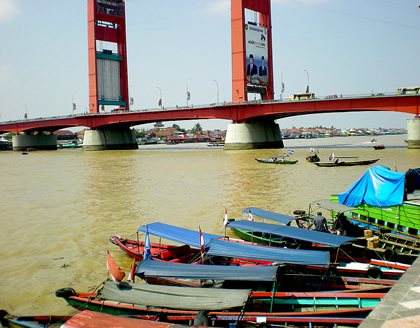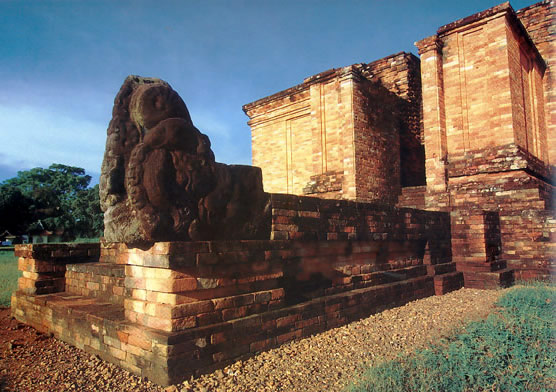The Sailendra dynasty was based in the Kedu plain in Java. They first appeared in the sixth century, around 570. The name Sailendra means “lord of the mountain,” a title derived from the Funanese kings, from whom they claimed descent.
By the middle of the eighth century the Buddhist dynasty had consolidated its territory in Java, ruling about two-thirds of its eastern area.
Bali, Lombok, coastal areas of Kalimantan, and southern Sulawesi fell under Sailendra control. Their sphere of influence extended to the Malay Peninsula and parts of Siam as well. Their greatest feat was building the Borobudur temple.
  |
Prince Patapan cut their prosperity short; the neighboring Sanjaya dynasty usurped the throne in 832, forcing the Sailendra prince to hide in the forest. The latter returned in 850 but was defeated and fled to the Srivijaya kingdom.
The Buddhist kingdom of Srivijaya was located on the large island of Sumatra. The name Srivijaya means “great victory.” Most likely the Srivijaya kingdom was on the southeastern coast of Sumatra, including Palembang, another city farther inland along the Musi River.
Palembang was probably the center of the ancient Malay kingdom. Evidence supporting this view includes a rectangular enclosure encircled by a moat, forming a fort known as Bamboo Fort.
Chinese porcelain shards were discovered in the settlement along the coast. According to a stone inscription dated 683, the founder of the kingdom was a Malay war chief who lived along the river.
He waged war against his rival, the Jambi-Melayu, and emerged victorious. The ruler managed to gather support from neighboring polities along the Musi River, which led to the formation of the Srivijaya kingdom, with Palembang as the core area.
The Srivijaya kingdom achieved commercial dominance as a maritime power because the mouth of the river Musi was rich with silt and therefore very fertile for the cultivation of crops, including rice.
   |
The ancient Malay polity was a coastal power that controlled the Malacca Straits as well as the Sunda Straits, from the late seventh century to the 12th century, though the kingdom might have been in existence since the third century.
The straits were busy routes as ships often passed through them as they traveled between China and India. Among the many ports in the area, Srivijaya was the most powerful.
It ruled over the coasts of the Malay Peninsula, Sumatra, western Kalimantan, western Java, and the Isthmus of Kra. Srivijaya was mainly a maritime power; its control did not extend to territories far inland.
Because of its widespread dominion, Srivijaya, together with its rival, the kingdom of Jambi, was able to spread Malay culture throughout the Malay Archipelago in the Malay Peninsula, Java, Sumatra, and Borneo.
Srivijaya consisted of three main zones—the estuarine region of the capital city Palembang, the hinterland formed by the Musi River basin that maintained a relative amount of independence but with loyal pledges to the Srivijaya ruler, and former rival estuarine zones.
The Buddhist king built monasteries, visited them often, and gave money to Buddhist monks traveling to India who frequently stopped in the fortified city. A trunk of a large statue of Buddha, remains of a stupa, old bricks, and other Buddhist statues from the late seventh to eighth centuries have been found on the slope of a hill about 100 feet high, known as Bukit Seguntang.
A Chinese monk, I Ching, who visited Srivijaya in 689, wrote that many Chinese monks stayed in the monasteries of Srivijaya long enough to learn the Malay and Sanskrit languages, before continuing their journey to India.
 |
| Musi River Palembang, nowdays |
Srivijaya was sometimes referred to as Jinzhou, or the “Gold Coast.” This was because Srivijaya’s wealth and fame were mainly due to the reserves of gold found within its kingdom.
Srivijaya influence began to decline in the 11th century, weakened by attacks from the Javanese, and the Singhasari dynasty was followed by the powerful Majapahit dynasty. Aceh achieved prominence in the region as a center of Islam, as it was one of the first ports frequented by Indian Muslim and Arab merchants.
The spread of Islam undermined Srivijaya authority in the region. Finally in 1414 the last Srivijaya ruler, Parameswara, became a Muslim. He founded a sultanate in Malacca, a coastal town on the western coast of the Malay Peninsula, and it thrived as an important port.

